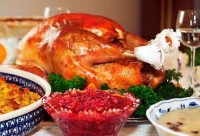Comhaireamh Síos Lá an Altaithe Posted by róislín on Nov 18, 2012 in Irish Language
(le Róislín)
In previous Thanksgiving blogs, we’ve counted turcaithe and puimcíní. This time, let’s count some favorite foods eaten on Lá an Altaithe i Meiriceá and some of the accessories used to cook or serve them. True, a multitude of turkey basters and lacers in one place might sound rather, well, awesome, but it’s all in the name of counting practice, sorting out your lenitables from your eclipsables, right?
But first let’s review the basic rules for counting things. Remember, for counting objects, we’ll be using the bunuimhreacha (cardinal numbers), not the maoluimhreacha (independent numbers). Sometimes both forms are the same, as in “cúig” (which is both the bunuimhir and the maoluimhir). But these four numbers show the following differences:
| Maoluimhir | Bunuimhir | |
| 1 | A haon (aon) | amháin |
| 2 | A dó (dó) | dhá |
| 4 | A ceathair | ceithre |
| 8 | A hocht (ocht) | ocht |
For “one,” we use two completely different words (aon, amháin), and “amháin” comes after the noun (turcaí amháin). All the other numbers come before their noun (dhá thurcaí).
For “two” and “four,” we use distinctly different but etymologically related words (dó, dhá; ceathair, ceithre).
For “eight,” the only difference is in the prefixed “h,” which is used for the “maoluimhir” (“ocht mbus” but “Bus a hOcht”)
The “maoluimhreacha” are used for telling time (a haon a chlog), giving a phone number (a dó, a haon, a dó), reading out lottery ticket numbers (a ceathair, a hocht, a cúig déag, a sé déag, fiche a trí, daichead a dó), doing arithmetic (a haon agus a haon, sin a dó), or counting for the sake of counting, as in a countdown. In other words, the maoluimhreacha are used independently of actual nouns or objects being counted. The bunuimhreacha are used to count objects (one box, two boxes, etc.). Here are the patterns:
1:- either use no number at all or “amháin.”
2 – 6: the number is followed by lenition (b changes to bh, c changes to ch, etc.) for all lenitable consonants (b, c, d, f, g, m, p, s, t)
7-10: the number is followed by eclipsis (b changes to mb, c changes to gc, etc.) for all eclipsable consonants (b, c, d, f, g, p, t)
So here’s our “turkey talk,” counting “síos” (in ord droim ar ais). Remember, the nouns stay singular but the adjectives modifying them (where present), are lenited and take the plural ending:
deich mónóg (hardly enough for an “anlann,” but that would take us into the hundreds)
naoi dtrinsiúr turcaí
ocht bpráta mhilse
seacht mbealaitheoir turcaí
sé ardaitheoir turcaí (NB: no lenition because this word starts with a “guta” and vowels cannot be lenited; if you’re wondering what a “turkey lifter” looks like, many look like a píce beag ceithre bheann, a small four-pronged pitchfork, sold in sets of two, but some are more of a tráidire miotail le lámha arda. Úúps — I gave away the definition, so that’s one less for the gluais)
cúig chairéad (now we’re into the lenition for the numbers 6 down to 2; 6 didn’t trigger lenition here as we just explained, because the noun following the number starts with a vowel)
ceithre bhior trusála turcaí
trí thurcaí mhóra bhlasta shúmhara
dhá phióg úll
agus, ag an deireadh,
piollaire frithaigéid amháin (An gcreideann tú gur ith tú an rud go hiomlán!)
For definitions for some of the less commonly used words, see the “gluais,” which is “thíos.” I didn’t want to put them side by side so you can challenge your memories from previous blaganna Lá Altaithe or from other seasonal reading.
And, of course, for practice saying the maoluimhreacha (independent numbers) out loud, please check out Transparent Language’s new video at http://www.youtube.com/watch?v=a-t5NzoxdfE)
Here are links to some previous blogs that demonstrate counting:
(https://blogs.transparent.com/irish/irish-numbers-1-20-with-video/ (shows the maoluimhreacha, with native speaker pronunciation)
Ag Comhaireamh Puimcíní (Counting Pumpkins in Irish) agus Beagán “Smashing” Freisin
Slán go fóill –Róislín
Gluais: anlann, sauce; bealaitheoir turcaí, turkey baster; bior trusála, turkey lacer; frithaigéad, antacid; go hiomlán, entire, whole; mónóg, cranberry (I’m still not convinced that an Irish “mónóg” and an American cranberry are exactly the same thing, but apparently they’re close enough for the Irish word to mean both); piollaire, pill, tablet; práta milis, sweet potato; súmhar, juicy; tráidire, tray; trinsiúr, platter
P.S. For those who like such things, here are three more ways to say “in reverse order” in Irish: ina mhalairt d’ord, san ord contrártha, san ord cúlaitheach. Not quite as many choices as we had for “icicle” in Irish (as you may recall from https://blogs.transparent.com/irish/cen-ghaeilge-ata-ar-rusticle-an-ann-di-do/) but an impressive array, nevertheless.
P.P.S. (25 Mí na Samhna) Athsmaoineamh: Cén Béarla atá ar na maisiúcháin ar chosa an turcaí? “Rufaí turcaí” a thabharfainn orthu i nGaeilge. I mBéarla? “Turkey frills.” Rudaí nár bhain mé úsáid astu riamh ach tá cuma dheas orthu sa phictiúr, nach bhfuil?

Build vocabulary, practice pronunciation, and more with Transparent Language Online. Available anytime, anywhere, on any device.





Leave a comment: